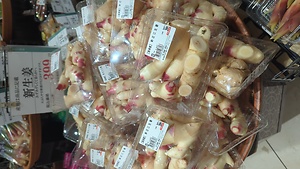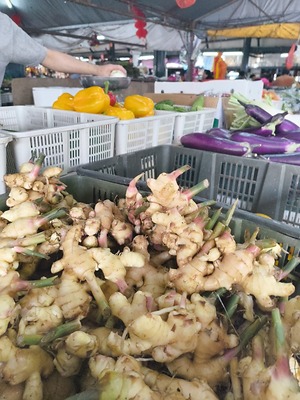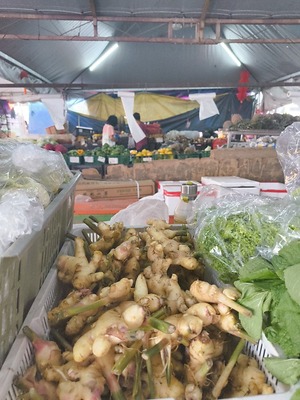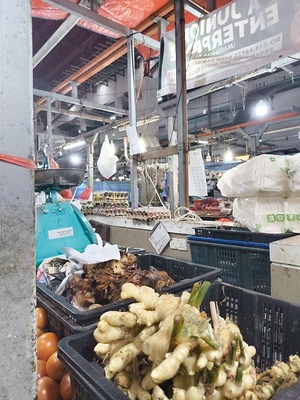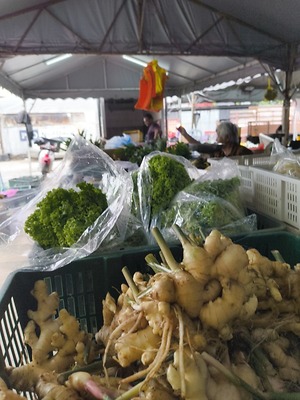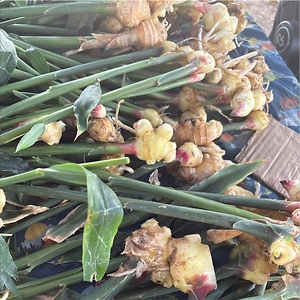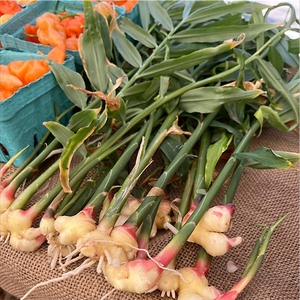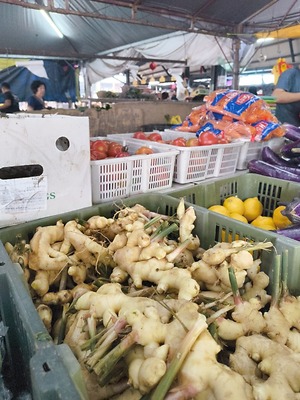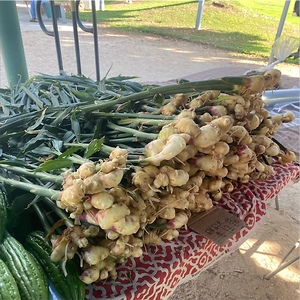


Young Ginger
Estimated Inventory, 30 lbs : 0
This item was last sold on : 06/19/25
Description/Taste
Young ginger is a knobby, multiple-branched rhizome. It can be found in many different shapes and sizes, growing up to ten centimeters long. This rhizome has a light, nearly translucent cream to tan-colored skin with darker brown spots and pink-purple blushing around the tips. This skin is soft, thin, and easily removed by hand. It has a much more tender texture and lacks the rough, calloused skin found in mature ginger. Underneath this skin, the ivory to cream-colored flesh is moist and succulent with a slightly spongy texture. This flesh is pliable and tender, almost fiber-free with a juicy, swollen, and crisp texture. Young ginger is aromatic, with a bright, mild flavor featuring notes of subtle pepperiness, floral undertones, and a hint of sweetness.
Seasons/Availability
Young ginger is available in the spring and early fall. It can be grown in greenhouses year-round.
Current Facts
Young ginger is botanically classified as Zingiber officinale and belongs to the Zingiberaceae family along with cardamom and turmeric. It is the immature rhizome of the tropical ginger plant. This variety, which is also known as Spring ginger, Baby ginger, and Pink ginger, is harvested at approximately 6 months rather than the standard 10 to 11 months. The ginger species' name comes from the Middle English term Gingivere and is also referred to as Srngaveram in Sanskrit, Ziggiberis in Greek, and Zinziberi in Latin. Ginger is one of the most consumed condiments in the world but is used differently depending on if it's in its mature or young state. Mature ginger has a spicy flavor that adds a distinct bite to dishes, while Young ginger offers a milder, juicier, and more tender flavor that imparts a subtler effect.
Nutritional Value
Ginger is one of the world’s oldest known remedies and has been used throughout history to ease nausea and indigestion. It's also a source of vitamin C, an antioxidant that helps boost the immune system, supports collagen production for healthy skin, and aids in the absorption of iron. Fiber found in ginger supports digestive health by promoting regular bowel movements and helping to maintain stable blood sugar levels. Iron is present in ginger, playing a crucial role in oxygen transport throughout the body and supporting immune function and energy metabolism. Potassium is another important mineral in ginger that helps regulate fluid balance, muscle contractions, and nerve signals, and can contribute to reducing blood pressure. As ginger matures, it develops a higher concentration of its medicinal compounds, such as zingerone, shogaol, and gingerol. Gingerol is known for its potent anti-inflammatory and antioxidant properties, while shogaol and zingerone have been studied for their potential to alleviate nausea, reduce pain, and protect against certain diseases.
Applications
Young ginger is best suited for raw applications as its flavor is mild and less pungent than mature rhizomes. The flesh does not need to be peeled and can be thinly sliced or minced and added to stir-fries, whisked into salad dressings, stirred into kimchi or pickled carrots, tossed into salads, or mixed with soups and stews. Young ginger can also be candied or steeped with sugar and water to make a simple syrup that can be used in sorbets, cocktails, wine, and kombucha. Young ginger pairs well with plums, cranberries, corn, kale, arugula, scallions, sauces such as fish sauce, soy sauce, and oyster sauce, rice vinegar, noodles, and rice. The rhizome will keep up to one week when stored in a paper bag in the crisper drawer of the refrigerator. It can also be sliced thinly and frozen for extended use.
Ethnic/Cultural Info
Pickled ginger root, known as gari in Japanese, is typically made from Young ginger soaked in a mixture of rice vinegar and sugar. The cream-colored Young ginger turns light pink when combined with this mixture and is often used as a palate cleanser at Japanese restaurants. Gari has been eaten with sushi since the Edo Period in Japan and likely gets its name from the sound it makes when eaten or cut. It is commonly consumed between pieces of nigiri to help the diner fully appreciate the different flavors of the fish. Gari is also useful when eating sushi by hand, as its slightly wet texture prevents rice from sticking to dry fingers. Gari aids in applying soy sauce to certain types of sushi, acting like a brush to coat the sushi in soy sauce without losing its toppings.
Geography/History
Ginger has been cultivated in India and China for up to 7,000 years. The first record of ginger dates back to around 2000 BCE when Indian traders introduced this rhizome to Rome and Greece. During the Middle Ages, ginger gained popularity outside of the Mediterranean and Spanish explorers soon brought the root to the New World in the mid-1500s. Young ginger is harvested in temperate and tropical climates or grown in heated greenhouses. It isn’t sourced from the wild because it needs to be harvested early to achieve a tender, mild flavor. Young ginger isn't as widely available as its more mature counterpart but can be sourced in Asian countries like Japan, China, India, Thailand, Vietnam, Korea, Indonesia, and Malaysia. In the United States and Canada, Young ginger is most likely to be found in Asian specialty stores and farmers’ markets.
Featured Restaurants
Restaurants currently purchasing this product as an ingredient for their menu.
| Bea Green Cold Pressed Juice | Alpine CA | 619-398-6295 |
| Pamplemousse Grill | Solana Beach CA | 858-792-9090 |
Recipe Ideas
Recipes that include Young Ginger. One
| The Kitchn |
|
Ginger Pumpkin Pie |
| My Wok Life |
|
Asian Soy Sauce Young Ginger Chicken |
| The Bojon Gourmet |
|
White Nectarine Prosecco Sangria with Ginger and Elderflower |



